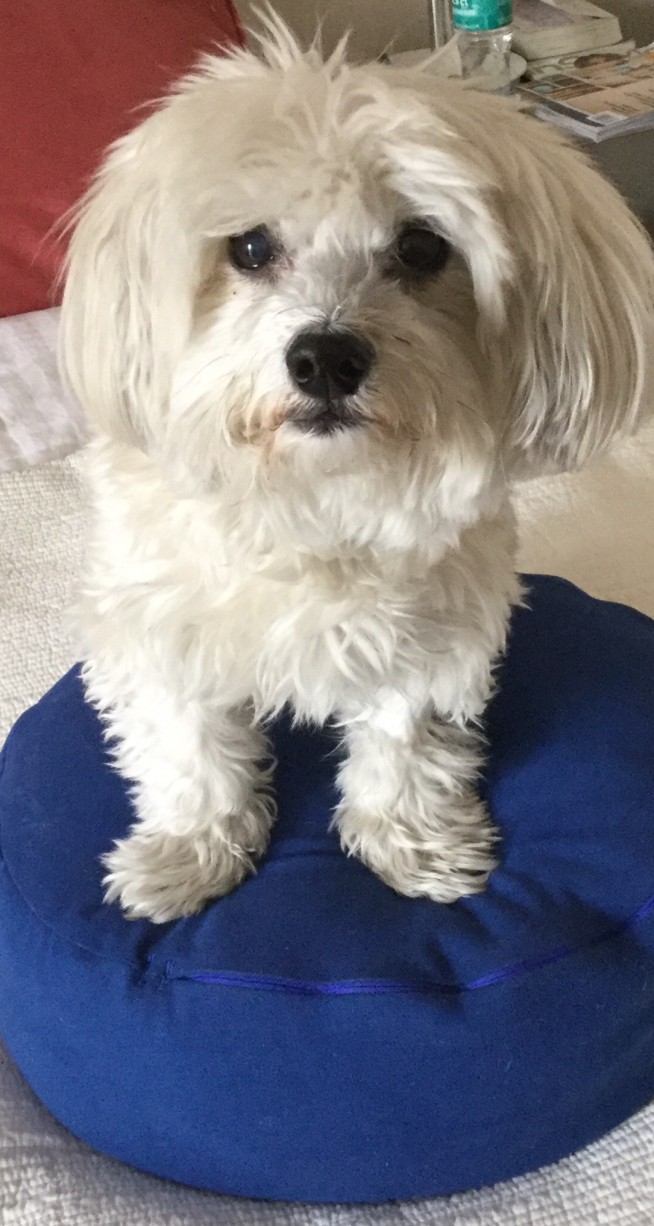Oliver was a three-month-old puppy when I brought him home. This little bundle of cuteness was so irresistible that there was no alternative but to say yes when asked if I wanted him. Yes to my first dog as a grown-up. Yes to this cream-colored Havanese with the relentlessly soulful eyes. Just yes. For just this once, there was not a moment of hesitation.
Three days later, I found myself on the kitchen floor, rocking back and forth, wondering what I’d done. This funny, quirky, active, spunky little pup was mine and I had no idea what to do with him.
I bought books with titles like “How to Behave So Your Dog Behaves” and “Mother Knows Best,” and read them with verve, as if I could soak every word off the page and become, well, the best dog whisperer ever. I’d know exactly what to do when he couldn’t sleep; when he barked for no apparent reason’ when he sat down on the road and signaled there would be no more walking five minutes into our walk; when his separation anxiety became painful for both of us.
As I got to know this little Aries, his stubborn willfulness began to blend with his increasing anxiety. I didn’t name it that at first, but as I would take out my rolling black suitcase to leave on business trips or begin a routine that looked ‘out of the ordinary’ to this clever guy, he’d begin taking things out of my suitcase, inserting himself between me and my computer, gluing himself to my lap or my heels as a signal that leaving was not an option. Worst of all, when I actually gently closed the front door as I was leaving the apartment, the wailing sound that would come next would remind me of mourners at a final pilgrimage in Varanasi, India. It was piercing and heartbreaking and would stay with me until I convinced myself that he would only wail for five minutes and then ease back into his day, plop on a fluffy pillow on the couch and begin dreaming of sweet curly-haired pups with pink and gold collars. Sadly, this wasn’t the case. In fact, I would often go up and down in my NYC building elevator, sticking my head out as I arrived on the 10th floor to listen, making sure he was calm before I’d leave on a business trip. Countless times, I told myself I should quit my job so I’d never have to leave him. Of course, that would mean a smaller treat budget for him, so I told myself he’d choose anxiety over no treats. Magical thinking.
Oliver’s almost thirteen years old now. His habits have become more rooted and his anxiety more predictable. Maybe it’s part of his breeding; perhaps he left his mother too soon; perhaps he’s my teacher, a reminder that:
Sometimes we can try every possible solution and things remain as they are. @meditationsapp (Click to Tweet!)
I’ve come to accept this part of him and to minimize his stress when possible. I pack while he’s in a deep sleep; I take my suitcase to the car the night before I’m leaving so that when I’m actually ready to leave, it looks like any other ordinary day; I avoid doing anything unusual that might be a tip-off that I’m heading out.
I wish Oliver could do what the rest of us can do when we’re feeling anxious…Meditate. Oliver is a worrier, and like many of the 40 million Americans (people, not dogs) who suffer from anxiety, his brain is wired for this habit now. According to Elisha Goldstein Ph.D., psychologist, mindfulness teacher, author and flagship instructor on the meditationstudioapp, the fuel that keeps anxiety going is that cascade of thoughts that flood our mind. This worrying can take on a life of its own and then we’re stuck in a worry loop that leads to fear or panic which activates the flight, flight or freeze reaction that mucks with our autonomic nervous system. Elisha says that when we meditate, we can train to focus on a single object (breath, mantra, other) and this helps to turn the volume down so that we’re not laboring over ill-fated predictions of worst-case scenarios over and over.
When we meditate, we learn to relate to this anxious feeling in a more skillful, thoughtful way that is healthier for us.
Oliver, for example, might be able to see that I’m leaving, but would now have the self-awareness to just notice that separation is difficult, without attaching the intensive worry (and what if’s) that accompanied those feelings before.
Here are the meditations that I’d recommend for him from the meditation studio app anxiety collection:
Ease Fear of the Unknown
Everything Changes
Dealing with Difficult Moments
Anxiety Release
I’m sure these would help to soothe and calm Oliver’s little nervous system. While meditation may not be an elixir for everyone with anxiety, it can ease our fixation on past or future fears and worries so we can live more peacefully in the present moment.
Until then, I’ll continue to sneak my suitcase out of my apartment in the middle of the night.
For more on Elisha Goldstein, check out his Untangle podcast interview on Happiness here.
Patricia Karpas is the co-founder and head of content for Meditation Studio LLC, the home of Meditationstudioapp.com. This 5-star app includes 200 meditations, 16 collections, 3 courses and 27 teachers. The app focuses on stress, anxiety, pain, sleep, happiness, confidence, performance and so much more, providing tools for beginners and experienced meditators. It’s a must have! She’s also the host of Untangle, the podcast that showcases the stories of experts, authors and real people whose lives have been transformed by meditation or mindfulness practices.













